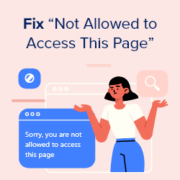
Are you annoyed by the WordPress error “Sorry, you are not permitted to access this page”?
When you try to see a page in your WordPress dashboard that your user role doesn’t have permission to see, you’ll get this error.
However, even if you are intended to have access to that page, you may get the error. This issue can be caused by a variety of factors, making it difficult for beginners to diagnose.
We’ll teach you how to solve the “Sorry, you are not permitted to visit this page” problem in WordPress in this post.
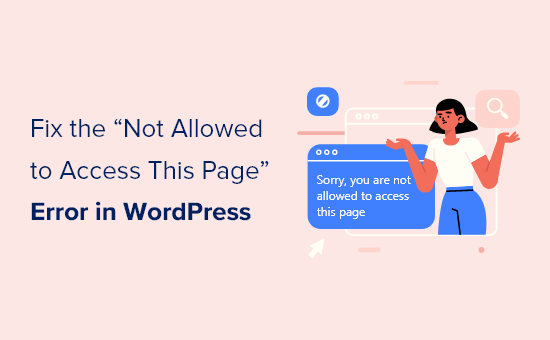
Contents
What Causes the WordPress Error “Sorry, You Are Not Allowed to Access This Page”?
User roles and permissions in WordPress determine what your users can and can’t do. For example, an author on your site would only be allowed to change their own posts, not the posts of other authors.
When an author clicks on a link to modify someone else’s post, they are greeted with the “Sorry, you are not permitted to access this page” WordPress error.
However, you may occasionally get “Sorry, you are not permitted to visit this website” when you should be able to.
If you are not the site owner or administrator and are encountering this error, please contact the site owner or administrator to inform them. They may either explain why you don’t have access to the page or adjust your role to allow you to view it.
If you’re the site owner or an admin, but you’re still getting the “Sorry, you’re not permitted to access this page” issue when attempting to log in to your own website, something is wrong with the permissions.
It’s possible that a WordPress upgrade caused the problem. Perhaps an issue occurred when a theme or plugin was updated. Or it’s possible that anything went wrong with your settings.
If you get this issue when trying to log in, you won’t be able to resolve it via the dashboard by altering your WordPress settings. You’ll have to deal directly with the files and databases.
For newcomers, this may be difficult, and making a mistake might make matters worse. As a precaution, we recommend that you back up your WordPress website completely.
You might also begin by contacting your web host. They might be able to help you with your situation.
As a result, here are some troubleshooting and repair procedures for the “Sorry, you are not permitted to visit this page” problem in WordPress.
Checking to Make Sure You’ve Got the Right WordPress Role
If you can get into the WordPress dashboard but not individual pages, it’s possible that your WordPress user role has been altered and you’re no longer an administrator.
You can view your user role in the WordPress dashboard by going to Users > All Users and looking under the ‘Role’ column.
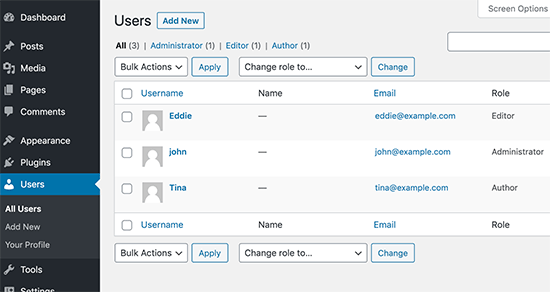
If you don’t have access to the Users page, it’s because you’re not a system administrator.
You can create a new administrator user using phpMyAdmin if you or someone else unintentionally deleted your administrator account or altered your user role.
Examining the.htaccess File for Errors
If you have the admin user role but still get the “Sorry, you are not permitted to view this page” issue, it might be due to a corrupt. .htaccess file. By renaming the file, we can verify this.
You’ll need to utilize an FTP program or your WordPress hosting account’s file management to do this. If you’ve never used FTP before, check out our tutorial on how to upload files to WordPress via FTP.
You must browse to the root folder holding all of your WordPress files using your FTP client. Once you’ve located the .htaccess file, change it to something else, like .htaccess.old.

If you can’t discover your .htaccess file, follow our instructions on how to locate it in WordPress.
Try login into your WordPress site after renaming the file to check whether the problem has been resolved. If it hasn’t already, change it to .htaccess and go to the next step.
If you are able to log in, the issue has been resolved. The following step is to make a new .htaccess file. Navigate to WordPress’s Settings » Permalinks page to do so.
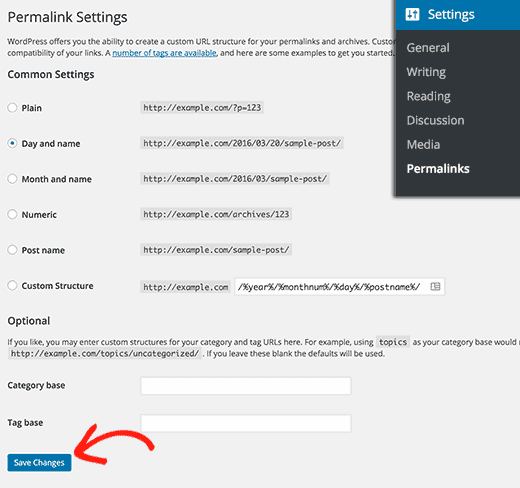
Simply click the Save Changes button at the bottom of the page to have WordPress create a new .htaccess file for you.
Examining File Permissions for Errors
We’ll check to see if there’s an issue with your file permissions while you’re using your FTP client. Who may access files and folders on your website is controlled by file permissions.
For most users, the following settings are recommended:
For all directories and subfolders, use 755.
For all files, use 644.
Select the wp-admin, wp-content, and wp-includes folders from the root folder holding all your WordPress files using your FTP client. Then pick ‘File Permissions’ from the context menu.

The file permissions dialogue box will appear as a result of this.
You must now type 755 into the numeric value area. After that, pick the ‘Apply to directories only’ option and tick the ‘Recurse into subdirectories’ checkbox.
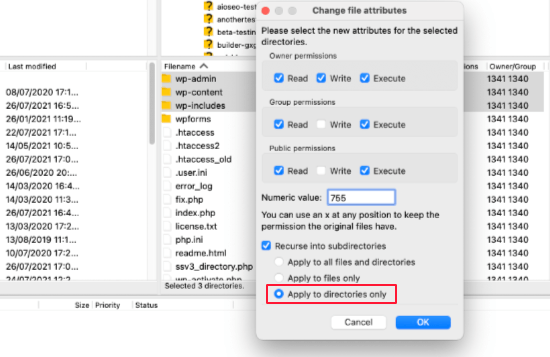
To proceed, click the OK button. File permissions for folders and subfolders will be specified by your FTP client. You’ll have to wait till it’s finished.
Next, pick all files and folders in your WordPress site’s root folder, then right-click to choose file permissions.

The dialogue box for file permissions would display.
This time, the numeric value should be 644. After that, pick the ‘Apply to files only’ option and tick the ‘Recurse into subdirectories’ checkbox.
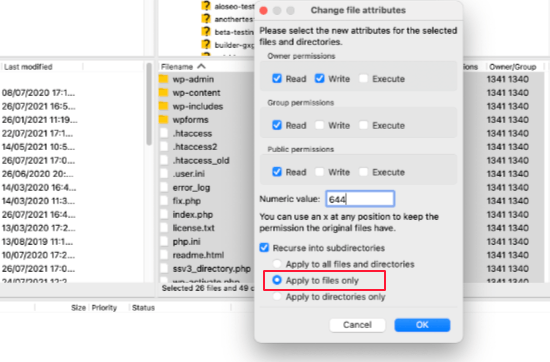
To proceed, click OK, and your FTP client will begin changing file permissions for all files on your WordPress site.
After that, try login into your WordPress website once more. You’ve solved the problem if you’re successful. If this is not the case, go to the next step.
Using FTP to deactivate all plugins
If the procedures above haven’t remedied the problem, we’ll look into if the error is being caused by a defective WordPress plugin. We’ll do this by temporarily turning off all plugins.
To begin, use an FTP program to connect to your website. You must go to the /wp-content/ folder once you’ve joined.
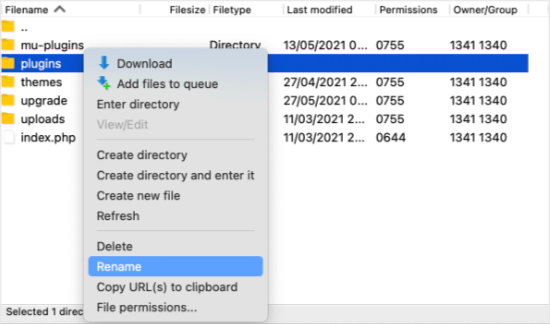
There will be a plugins folder there once you get there. This is where WordPress keeps track of all the plugins you’ve installed on your site.
To rename the plugins folder, right-click it and select Rename. After that, you should enter a different name. We’ll refer to it as ‘plugins.deactivate.’
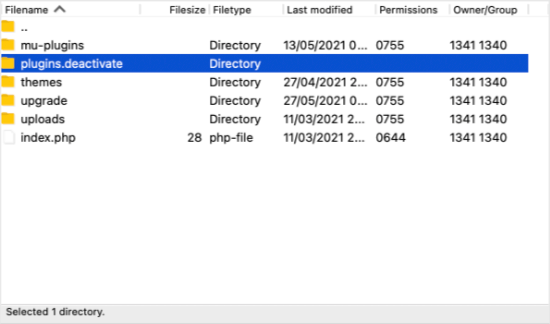
Your plugins have all been disabled. Now try logging into your WordPress site to see whether the problem has been resolved.
If the message “Sorry, you are not permitted to access this page” persists, the issue is not due to a plugin. To proceed to the next step, rename the ‘plugins. deactivate’ folder back to ‘plugins’.
If you can now log in, it’s likely that one of the plugins is to blame. All we have to do now is figure out which one it is.
Rename the ‘plugins. deactivate’ folder to ‘plugins’ in your FTP client, then browse to the plugins folder. Replace the first plugin’s name with something like ‘plugin-name.deactivate.’
Return to your website and see if you can log in. If you are unable to do so, rename the plugin and go on to the next. Repeat the procedure until you’ve identified the culprit.
You can switch to a different plugin that doesn’t cause the problem once you’ve located the broken one. Alternatively, you may contact the plugin’s author and collaborate with them to find a solution.
Using FTP to Activate the Default Theme
If the plugin solution doesn’t work, we’ll need to see if the problem is caused by your WordPress theme.
Deactivating your plugins is comparable to this process. You’ll need to use an FTP program to connect to your website and browse to the wp-content folder.

There will be a folder named themes once you get there. This is where WordPress saves all of your website’s themes.
This time, right-click on the plugins folder and choose Rename from the menu. We’ll refer to it as ‘themes.deactivate.’
This will make the default theme active. Now try logging into your WordPress site to see whether the problem has been resolved.
If you’re still getting the “Sorry, you’re not permitted to access this page” message, it’s not a theme issue. Rename the ‘themes. deactivate’ folder to ‘themes’ before proceeding to the next step.
If you can log in, the problem was created by the previous theme, and you may begin troubleshooting. You might try an alternative theme or reinstall and carefully customize the same theme.
If the error reappears, contact the theme’s creator. They might be able to assist you in resolving the issue of repairing a theme flaw.
Steps for Final Troubleshooting
If you’re still reading, it’s because the previous steps didn’t address your problem. Here are a few more ideas for you to consider.
Examine the Error Log
An error log may provide information on what went wrong. Your hosting provider may maintain logs, or you may have already configured WordPress to do so.
For more information, see our tutorial on configuring WordPress error logs or contact your hosting provider.
Install the most recent PHP version.
If your WordPress site is utilizing an older version of PHP, it might be causing issues. Upgrading to the most recent version may be beneficial.
For additional information, see our tutorial on how your web host’s PHP upgrades affect your WordPress site, or contact your hosting provider.
Return to the Most Recent Backup
If you’ve made a recent backup of your WordPress website, restoring it to a previous version should resolve the “Sorry, you are not permitted to view this page” problem.
The issue is that any changes to your settings and material made after the backup will be lost.
Check out our beginner’s guide on restoring WordPress from backup for more details.
Please contact your hosting provider.
If you are unable to resolve the problem on your own, you should contact your WordPress hosting company to see what they can do.
Many carriers give outstanding technical assistance and may be able to help you resolve the issue.
They may, for example, be able to examine their server error logs or have generated their own backups of your WordPress site. They will be able to advise you on how they can assist you and what steps you should take next.
Check out our article on how to properly request and get WordPress assistance for the best results.
We hope this guide has shown you how to resolve the “Sorry, you are not authorized to view this page” problem in WordPress.
